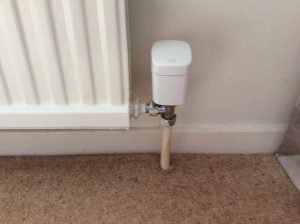Last night I made a small update to our heating system by adding some smart radiator valves. I’d been thinking for some time that there were efficiencies to be made regarding what rooms were heated when. Until now we’ve had a 7 day heating timer (so we have different heating schedules on weekdays and weekends) and thermostatic radiator valves (so we can set specific temperatures in each room) but now we’ve gone a step further.
These days there are in my opinion three types of radiator valves:
- Traditional proportional valves – these valves allow the flow to a radiator to be set manually, but there’s no control to maintain a set temperature. So if for example a room is south-facing it may get too hot on a sunny day as no account is made of the solar gain, or a relatively exposed room may get too cold on a windy day as no account is made for the extra heat loss.
- Thermostatic valves – here the user can set a temperature for each valve, and then internal expansion or contraction of the thermostat reduces or increases the flow through the radiator to maintain the set temperature; but all radiators heat at the same times as set by the heating timer.
- Smart valves – smart valves add the ability to schedule temperature and/or on and off periods in different rooms at different times.
In my case I identified 3 rooms (5 radiators total) in which I thought that the typical usage was different enough from the house as a whole to warrant smart valves. For the purposes of illustration only, I’ve also added the schedule for the boiler timer although this is programmed independently of the radiator valves. The three rooms are:
- Lounge – we don’t use the lounge on termtime weekday mornings.
- Master bedroom – we don’t use the room during the day, so the heating can stay off until towards bedtime.
- Play room – my daughter doesn’t use her playroom before nursery or after her bedtime.
The chosen smart valves are Elgato Eve Thermos which are Apple HomeKit compatible but are also configurable via Elgato’s own App; but not configurable via non-Apple devices. I initially tried setting up the required sequences via timed scene changes, but couldn’t see an easy way to schedule both workdays and days off; so I ended up downloading schedules directly into the valves via Elgato’s own App. This allows different schedules to be established easily for both working and non-working days with a schedule to identify non-working days set in as a calendar in my iPad. It’s easy to set up a recurring schedule for weekends and then other dates like bank or school holidays can quickly be added. Vacations when we’re away from home are still set up via timed scene changes.



Last week I came across a 4th variation. The holiday home that we stayed in had some radiators which, in additiona to an optional TRV, also had a mains-controlled solenoid driven by a central controller. The effect of this was that the solenoid could prevent the individual radiator from warming according to whther the adjacent outet was enabled. I assume that an therwise unidentified controller by the hot water cylinder controlled this functionality.